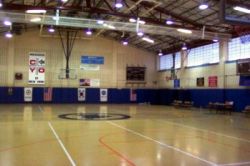Kwame Ture Recreation Center
Kwame Ture (Stokely Carmichael) Recreation Center
What was here before?
This once was part of a large piece of property belonging to the Devoe family, who descended from French Huguenots that arrived in New York in the 17th century. The wooden Devoe Cottage was built on the property in 1804. The cottage was demolished in 1926, and in the 1930s several six-story apartment buildings were constructed on the site. By the 1980s, many of these buildings were torn down, leaving a vacant lot.
How did this site become a recreation center?
In 1999, the NYC Department of Youth and Community Development built the West Bronx Recreation Center. At the time that it was built, it was owned by NYC Parks but programmed and managed by Catholic Youth Services, a community-based organization. Due to staffing shortages and financial challenges, operations of the center were assumed by NYC Parks in 2011.
The center features a gymnasium that includes three basketball courts and two volleyball courts, as well as a fitness studio and computer room. A multi-use synthetic turf ballfield, added to an adjacent lot outside the center in 2008, is used for soccer, softball, and little league games.
Who is this recreation center named for?
In 2021, as part of the second phase of NYC Parks’ initiative to expand the representation of African Americans honored in parks, this recreation center was named for political activist Kwame Ture/Stokely Carmichael (1941-1998).
Kwame Ture was born Stokely Carmichael in Port of Spain, Trinidad on June 29, 1941 and immigrated to Harlem in 1952. He attended the Bronx High School of Science and in 1960 he enrolled at Howard University, where he became a member of the Student Nonviolent Coordinating Committee (SNCC). The following year he participated in the Freedom Ride through the south, during which time he was jailed for seven weeks in Jackson, Mississippi.
Following his graduation in 1964, Carmichael continued to be active with the SNCC, becoming chairman in 1966. While organizing the Lowndes-County Freedom Organization in Alabama, he selected a black panther as the party’s logo, which would become the emblem of the Black Panther Party. Carmichael was also an outspoken opponent of the Vietnam War.
While he initially supported nonviolent measures and the push for racial integration, he became increasingly frustrated after beatings and murders of fellow activists. He founded the “Black power” movement which encouraged self-defense, self-determination, political and economic power, and racial pride. The phrase became a provocative rallying cry that drew criticism and backlash from many, both outside and inside the civil rights movement. After the SNCC broke ties with Carmichael in 1967, he was named the Black Panther Party’s honorary prime minister until he stepped down in 1969.
The same year, he moved to Guinea, West Africa. He changed his name to Kwame Ture, in homage to early socialist, Pan-Africanism advocates Kwame Nkrumah and Ahmed Sékou Touré, and founded the international All-African Revolutionary Party.
He wrote several books, including Black Power (1967) and Stokely Speaks: Black Power Back to Pan-Africanism (1971). Carmichael was married and divorced twice, first to South African singer Miriam Makeba (1932-2008) and later to Guinean doctor Marlyatou Barry and had two sons. He lived in Guinea until his death in 1998.
Check out your park's Vital Signs
Clean & Safe
Green & Resilient
Empowered & Engaged Users
Share your feedback or learn more about how this park is part of a
Vital Park System

Know Before You Go


